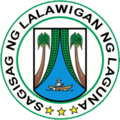Pakil, Laguna
Pakil, officially the Municipality of Pakil (Tagalog: Bayan ng Pakil), is a 5th class municipality in the province of Laguna, Philippines. According to the 2015 census, it has a population of 20,659 people.[3]
Pakil | |
|---|---|
| Municipality of Pakil | |
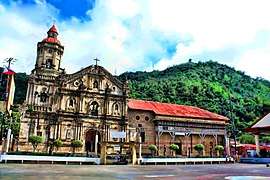 San Pedro de Alcantara Church | |
 Seal | |
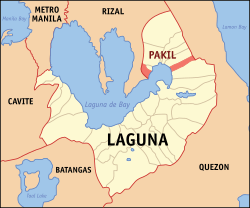 Map of Laguna with Pakil highlighted | |
OpenStreetMap 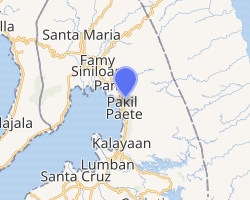
| |
.svg.png) Pakil Location within the Philippines | |
| Coordinates: 14°23′N 121°29′E | |
| Country | |
| Region | Calabarzon (Region IV-A) |
| Province | Laguna |
| District | 4th District |
| Founded | 1676 |
| Barangays | 13 (see Barangays) |
| Government | |
| • Type | Sangguniang Bayan |
| • Mayor | Vincent Soriano |
| • Vice Mayor | Vipops Charles D. Martinez |
| • Congressman | Benjamin C. Agarao Jr. |
| • Electorate | 15,058 voters (2019) |
| Area | |
| • Total | 46.50 km2 (17.95 sq mi) |
| Population (2015 census)[3] | |
| • Total | 20,659 |
| • Density | 440/km2 (1,200/sq mi) |
| • Households | 4,571 |
| Economy | |
| • Income class | 5th municipal income class |
| • Poverty incidence | 11.91% (2015)[4] |
| • Revenue (₱) | 65,026,144.94 (2016) |
| Time zone | UTC+8 (PST) |
| ZIP code | 4017 |
| PSGC | |
| IDD : area code | +63 (0)49 |
| Climate type | tropical monsoon climate |
| Native languages | Tagalog |
Its land area consists of two non-contiguous parts, separated by Laguna de Bay.
History
The land from Punta Inuod to Guinabihan, Banilan is where the first settlers Gat Maitan and his wife Panumbalihan, and Gat Silayan Maginto and his wife Potongan first established themselves. After a series of raids by pirates and marauders, they moved to the present site of Poblacion, leaving behind Chief Maginoong Dalaga who ruled the place. This account explains why Pakil has two territories on the eastern and western sides of the lake. Gat Maitan and Gat Silayan are one of the borne-leaders from the ancient town of Malolos which was called by pre-colonial Chinese traders from Fujian as "Lihan" where Gats and Lacandolas abundantly reside along the shores of Manila Bay under the Kingdom of Tondo. Gat Silayan actually is one of the members of the ruling clan of Lihan whose names bearing prefix "gat" a royal title. Every member of the clan in Malolos called "Gat", and it became "Gatchalian", Gatmaitan, together with Lakandula and Gatbonton at the course of time[5]
When the Spaniard Conquistador together with the Augustinians stationed at Bay came to the place in 1571, this colony was under the leadership of Gat Paquil, a descendant of Gat Maitan whose name was used to name the settlement as "Paquil", which remained during the whole Spanish Regime and early part of the American period. It was changed to "Pakil" by Executive Order No. 77 in 1927.
When the Franciscan missionaries came in 1578 Order of Friars Minor (OFM) Pakil was attached to Paete in 1602 as its "visita". Padre Francisco Barajas, made efforts to separate this town from Paete, and Don Diego Jorge became the first Capitan Municipal or Gobernadorcillo on May 12, 1676 and finally Pakil was named as an independent town with the administration of "Capitan Municipal" at the helm of the local colonial government, the last of whom was Capitan Municipal Don Nicolas Regalado.
With the change of government from Spanish to American upon the total Occupation of the United States in the Philippines after the defeat of the Filipino Forces in Philippine -American War of 1898-1900, the Americans had to reorganize the pattern of the Civil Government in the country in 1901. It was Bernardo Gonzales was appointed the first Municipal President (Presidente Municipal) under American Period until November 25, 1903. Upon this reorganization, the Public Law No. 1009, of the Philippine Commission, the town of Pakil was merged with Pangil in order to reduce the number of existing towns whereas the weak towns to be merged with the stable one for the stabilization of local economy due to the damages of the previous wars. After nineteen years, On October 1, 1927, by virtue of Executive Order No. 77, Pakil was re-established into town thus the Municipality of Pakil was restored.
In 1942, the Japanese troops occupied in Pakil, Laguna and in 1945, the liberated from the Philippine Commonwealth forces under the Philippine Army and Philippine Constabulary entering in Pakil, Laguna with the local recognized guerrillas against the Japanese forces during the Second World War.
In 1954, the sitios known as Casa Real, Casinsin and Kabulusan were converted into barrios.[6][7][8] Durado followed suit in 1957.[9]
Barangays
Climate
| Climate data for Pakil, Laguna | |||||||||||||
|---|---|---|---|---|---|---|---|---|---|---|---|---|---|
| Month | Jan | Feb | Mar | Apr | May | Jun | Jul | Aug | Sep | Oct | Nov | Dec | Year |
| Average high °C (°F) | 26 (79) |
27 (81) |
29 (84) |
31 (88) |
31 (88) |
30 (86) |
29 (84) |
29 (84) |
29 (84) |
29 (84) |
28 (82) |
26 (79) |
29 (84) |
| Average low °C (°F) | 22 (72) |
22 (72) |
22 (72) |
23 (73) |
24 (75) |
25 (77) |
24 (75) |
24 (75) |
24 (75) |
24 (75) |
24 (75) |
23 (73) |
23 (74) |
| Average precipitation mm (inches) | 58 (2.3) |
41 (1.6) |
32 (1.3) |
29 (1.1) |
91 (3.6) |
143 (5.6) |
181 (7.1) |
162 (6.4) |
172 (6.8) |
164 (6.5) |
113 (4.4) |
121 (4.8) |
1,307 (51.5) |
| Average rainy days | 13.4 | 9.3 | 9.1 | 9.8 | 19.1 | 22.9 | 26.6 | 24.9 | 25.0 | 21.4 | 16.5 | 16.5 | 214.5 |
| Source: Meteoblue [10] | |||||||||||||
Demographics
| Year | Pop. | ±% p.a. |
|---|---|---|
| 1903 | 1,585 | — |
| 1939 | 2,451 | +1.22% |
| 1948 | 3,055 | +2.48% |
| 1960 | 4,765 | +3.77% |
| 1970 | 7,229 | +4.25% |
| 1975 | 8,375 | +3.00% |
| 1980 | 9,048 | +1.56% |
| 1990 | 13,438 | +4.04% |
| 1995 | 15,663 | +2.91% |
| 2000 | 18,021 | +3.05% |
| 2007 | 20,242 | +1.62% |
| 2010 | 20,822 | +1.03% |
| 2015 | 20,659 | −0.15% |
| Source: Philippine Statistics Authority[3][11][12][13] | ||
In the 2015 census, the population of Pakil, Laguna, was 20,659 people,[3] with a density of 440 inhabitants per square kilometre or 1,100 inhabitants per square mile.
Cultural heritage
Music was formally initiated in the town of Pakil by San Pedro Bautista (1586) the Guardian of the Franciscan order. He established the only Music Academy in the country. The school started with 400 children from towns along the Laguna Bay. These students started as church choir members and were taught how to make musical instruments out of locally available materials like bamboo, cans, wood and coconut shells. These kids were called “Tiple” and they trained other younger children to become members of the church choir.
The entire population became involved in teaching their youth to sing and play instruments. This tradition was handed down from generation to generation. The Adonay family influenced the spread of musical interest and helped form the first brass band in Pakil.
The elderly Tacio Celis helped train children to read musical notes and play instruments. Since then, many young musicians finished college on scholarships by playing for their school bands.
Currently Pakil Music Program is helping out young students to continue the rich musical heritage of the town. Pakil Music Program (PMP) is providing music education through note reading and instrument performances with the help of some retired musicians. The current executive director of the PMP is Mr. Roy Regalado.
St. Peter of Alcantara Parish
The St. Peter of Alcantara Parish, also the Diocesan Shrine of the Our Lady of Turumba is Pakil's Roman Catholic Church and home to the Our Lady of Sorrows de Turumba.
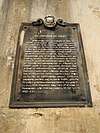 Historical Marker of Pakil Church
Historical Marker of Pakil Church- Facade of Parochial Office
- Original Painting of the Our Lady of Turumba
- Retablo of the Turumba Chapel
- Retablo-mayor
- Facade
- Pulpito
- Minor retablo with crucified Christ
Our Lady of Turumba
Nuestra Señora de los Dolores de Turumba ("Our Lady of Sorrows of Turumba") is the name for a specific statue of the Virgin Mary as Our Lady of Sorrows, enshrined in Pakil.
Liceo de Pakil
Liceo de Pakil is a private sectarian Catholic high school originally established by the Maryknoll Fathers in 1956.[14] At first, the school was named Maryknoll Fathers High School following the namesake of its leaders. When the Maryknoll Fathers had to go to their mission in Davao, they ceded the leadership to the Maryknoll Sisters who subsequently changed the school's name into Maryknoll High School. Upon the termination of the mission of the Maryknoll Sisters in 1972, Bishop Pedro N. Bantigue invited the Augustinian Recollect Sisters to administer the school. The name was changed again to Mary Immaculate Academy by the Augustinian Recollect Sisters. In 1982, the school's name was changed to Liceo De Pakil by the Diocese of San Pablo. The first batch to graduate under Liceo de Pakil was the batch of 1983 graduating class. In 1986, the administration of the school was passed on to the Missionary Catechists of St. Therese (MCST). Liceo De Pakil is currently under the administration of the MCST and the Diocese of San Pablo.[15]
Notable people
- Marcelo Adonay - major Philippine composer and church musician.[16]
- Danilo Echavaria Dalena - modern and contemporary painter.[17][18]
- Jun Regalado - one of the most prolific drummer in the Philippines.[19]
References
- "Municipality". Quezon City, Philippines: Department of the Interior and Local Government. Retrieved 31 May 2013.
- "Province: Laguna". PSGC Interactive. Quezon City, Philippines: Philippine Statistics Authority. Retrieved 12 November 2016.
- Census of Population (2015). "Region IV-A (Calabarzon)". Total Population by Province, City, Municipality and Barangay. PSA. Retrieved 20 June 2016.
- "PSA releases the 2015 Municipal and City Level Poverty Estimates". Quezon City, Philippines. Retrieved 1 January 2020.
- http://www.elaput.org/pinsika3.htm
- "An Act Converting the Sitio of Casa Real in Municipality of Pakil, Province of Laguna, to a Barrio to Be Known As Barrio Casa Real". LawPH.com. Retrieved 2011-04-11.
- "An Act Converting the Sitio of Casinsin in the Municipality of Pakil, Province of Laguna, to a Barrio to Be Known As Barrio Casinsin". LawPH.com. Retrieved 2011-04-11.
- "An Act Converting the Sitio of Kabulusan in the Municipality of Pakil, Province of Laguna, to a Barrio to Be Known As Barrio Kabulusan". LawPH.com. Retrieved 2011-04-11.
- "An Act to Convert the Sitio of Durado in the Municipality of Pakil, Province of Laguna, into a Barrio to be known as the Barrio of Dorado of Said Municipality". LawPH.com. Retrieved 2011-04-12.
- "Pakil: Average Temperatures and Rainfall". Meteoblue. Retrieved 11 May 2020.
- Census of Population and Housing (2010). "Region IV-A (Calabarzon)". Total Population by Province, City, Municipality and Barangay. NSO. Retrieved 29 June 2016.
- Censuses of Population (1903–2007). "Region IV-A (Calabarzon)". Table 1. Population Enumerated in Various Censuses by Province/Highly Urbanized City: 1903 to 2007. NSO.
- "Province of Laguna". Municipality Population Data. Local Water Utilities Administration Research Division. Retrieved 17 December 2016.
- https://www.dioceseofsanpablo.com/schools
- Citation needed
- "Featured Artist: Marcelo Adonay". Retrieved 2019-11-08.
- "Danilo E. Dalena Biography". Retrieved 2019-11-08.
- "The art of Danilo Dalena and the Filipino everyman". CNN Philippines. Retrieved 2019-11-08.
- "'50 Years of Drumming:' Jun Regalado marks milestone with all-star free concert". Philippine Daily Inquirer. Retrieved 2019-11-08.
External links
| Wikimedia Commons has media related to Pakil, Laguna. |
